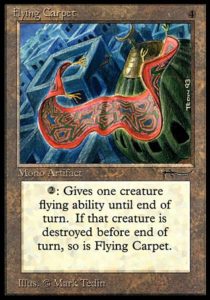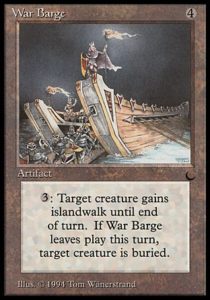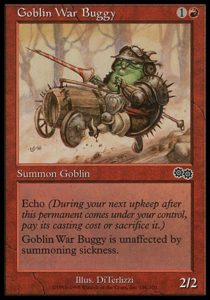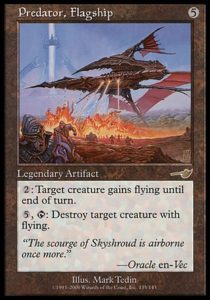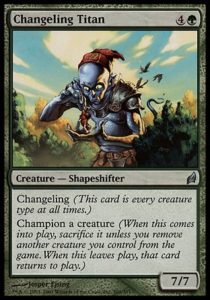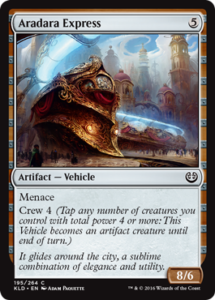The Kaladesh prerelease is only a few days away, and many of us can’t wait to get to Fabricate an army of servos, amass all the Energy, and crew some sweet, sweet Vehicles. However, we don’t have to wait until the weekend to play around with vehicles. Turns out, vehicles (much less equipment), are a design space Magic tried to figure out for years. And, much like equipment, vehicles disappeared for a while, then returned in their final form.
This article is dedicated to the history of Magic’s sweet rides.
The Real Hero of Flying Men
Flying Carpet is, to the best of my knowledge, the first artifact that a creature conceivably used by riding. It doesn’t at all resemble how vehicles function, but it is recognizably a vehicle which a creature rides. It’s notable that the first rideable artifact is delightfully simple and flavorful; it was created in an era where cards often cared more about hitting the right flavor notes than playing smoothly and easily. Our next examples exemplify this.
When You Crash, You Burn
Proto-vehicles like Flying Carpet existed alongside proto-equipment, like Sandals of Abdallah (both of which came out in Magic’s first expansion, Arabian Nights). The Sandals created the first distinction between early vehicles and equipment: if a creature wearing equipment died, the equipment was lost along with them. The reverse of this ability was added to the proto-vehicle, War Barge (three sets later, in The Dark). If War Barge was destroyed, everything riding the boat went down with the ship. This functionality was then combined in Ice Age’s Phantasmal Mount‘s mountain of text, where both horse and rider were essential to each others’ survival.
This distinction between early vehicles/mounts and equipment was inconsistent and short-lived. Most artifacts, like Coral Helm and Tawnos’s Weaponry, didn’t care what happened to the creature using them. It’s hardly surprising that this functionality was short-lived—it wasn’t fun, it made such artifacts play essentially just like auras, and it defied good flavor. If a creature dies, why do you bury a perfectly good weapon with them when you’re locked in mortal combat with another planeswalker? If their vehicle is destroyed, why can’t they swim, use magical parachutes, or just disembark to get to safety?
Vehicles as Creatures
Proto-vehicles were nowhere near as numerous as creatures with included-vehicles. If a creature was able to ride something, it was usually part of the creature itself.
Goblin Ski Patrol is clearly able to use its skis (once), Goblin Balloon Brigade has been flying through the air since Alpha (which makes it the first vehicle-riding creature, even if Flying Carpet was the first vehicle to ride), and Goblin War Buggy is . . . exactly what it says it is. For mounts (which can be seen as living vehicles), they were subsumed into a a creature’s abilities, as seen in Zhalfirin Knight‘s flanking, Kjeldoran Skyknight‘s flying, and Elven Riders‘ not-flying.
Airships Aplenty
There were still proto-vehicles in Magic’s second phase of expansions, and lots of them made creatures fly: Whalebone Glider and Chariot of the Sun continued the Flying Carpet tradition of granting flying to creatures, though they gained some complexity and lost some mana costs. However, Goblin Kites muscled in on their territory, muddling the distinction between proto-vehicles and enchantments. Predator, Flagship continued the tradition, but its rival airship and the most famous airship in all of Magic, the Skyship Weatherlight, runs contrary to this tradition (of skyships making creatures fly) and fails to interact with creatures at all (well, creatures which are on the battlefield and want to fly).
Let’s take a bit of a detour from artifacts and focus on the predecessors of the crew mechanic.
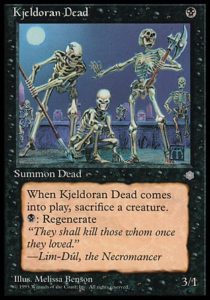
Dead Crew Tell No Tales
Kjeldoran Dead doesn’t look anything like a Renegade Freighter, but both cards are heavily discounted creatures for their mana cost, and both require creatures in order to live.
Yes, Kjeldoran Dead (and its descendant, Spined Fluke) explicitly requires a creature’s actual death, whereas the train never kills its crew (only keeping them functionally out of the game for a turn cycle when used). However, folks should recognize that both vehicles and these Ice Age zombies are parasitic creatures that require other creatures in order to do anything. In fact, this mechanic was used over a decade later in an even closer analogue for vehicles: champions.
Making Room for Something Better
Flavorwise, champions are completely different from vehicles: the creature is channeling, transforming into, or exchanging places with an exemplar of itself. However, the gameplay is recognizably similar to crewing a vehicle: while the vehicle is a creature, its crew is not, and vice versa.
However, there are some obvious and major differences: you can’t even play a champion if you don’t have a creature, you run the risk of being blown out by removal, and most champions had tribal interactions. Plus, champion doesn’t have anywhere near as much flavor as a vehicle: I’m not precisely sure just what the champion mechanic entails, but I think the majority of players immediately and intuitively understand what it means for a creature to crew a Smuggler’s Copter.
Champion doesn’t seem to have been particularly well-received as a mechanic, seeing as it’s never come back and is from an unpopular block. I’d imagine that if vehicles are successful, champion’s return will be even less likely, since they play in such similar design space.
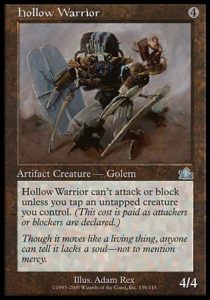
Mechsuits and Battlewagons
Sixteen years ago, Prophecy featured two neat takes on vehicles: Hollow Warrior and Keldon Battlewagon. Hollow Warrior looks a whole lot like a vehicle with Crew 1 (it has the original version of the mechanic, where you Crew cared about the number of creatures tapped, rather than total power). Keldon Battlewagon allowed you to tap any number of creatures, as Crew currently does, but instead of getting a freight train, you got a one-use battering ram of death. Keldon Battlewagon also gained the power of the creatures it crewed, which is a version of Crew discarded by the design team (for good reason).
These designs are worth discussing because Magic got a lot right about vehicles more than half its lifetime ago, but that was it. These designs didn’t look like a solid foundation for an entire mechanic, but many individual cards don’t. Guerrilla Tactics sure doesn’t look like a madness card, and Sandsteppe Outcast doesn’t look like a fabricate card (particularly since it was part of a cycle where each card gave you something different if you didn’t put a counter on it), but both cards are essential stepping stones on the way to those mechanics. It’s cool food for thought that today’s random card could be tomorrow’s major set mechanic.
All Aboard!
…and that’s a brief history of the brave artifacts, enchantments, and creatures that helped pave the way for both vehicles and the crew mechanic. Hopefully you’ve enjoyed this brief foray through the past and will have an absolute blast crewing your way to victory this weekend. Just make sure that you pack enough creatures to crew your trains, airplanes, and cars (’cause vehicles probably shouldn’t count as full creatures when you’re building a deck).
And, as always, thanks for reading.
—Zachary Barash
Zachary Barash is a New York City-based game designer. He’s played Magic since 1994, he loves Limited and drafts every available format (including several that aren’t entirely meant to be drafted). He loves Ulvenwald Mysteries, as it’s both a strong Limited card and tells a fantastic story entirely through its mechanics.

